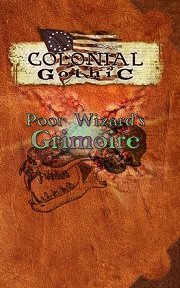
The book begins with an overview of what magic is, and explaining how virtually every culture has believed in its existence. The sweep of history, at least European history, is described in terms of the development of the study and use of magic by the Greeks (who treated it as just another subject to study, nothing special) and the Romans (where it was in the hands of a powerful society who protected the Empire, but whose disillusionment as the Empire decayed contributed to the fall of Rome), through the Dark Ages to the Renaissance, when magic as well as many other areas of knowledge saw a resurgance. In the time Colonial Gothic is set, it has its importance although it tends to be studied secretly rather than openly. Indeed there are many men of science and within the Church who believe that it is no longer practised... but they are wrong! Magic exists and can be tapped into only by those borm with the ability to do so. Outwardly, the Church stands in opposition to the study and use of magic, but inwardly opinions are divided.
Next comes a discussion of 'Rituals.' These are quite broad feats that can be performed to bring about a desired effect and come in two types, common and arcane. Common rituals are fairly easy to learn and most people who can do magic at all can perform them. Effects are minor and often transitory. Arcane ones are harder to learn and perform, but can have quite spectacular effects. Several examples are given, each laced with fascinating snippets of the history of their development and use, as well as details of what effect they create.
Chapter 2 is entitled Witchcraft. This art is different from magic cast through ritual: in witchcraft an item is made and embued with power, this item is then used to create the desired effect. In Colonial Gothic it is a dark art, used to cause harm; and it is recommended that only NPCs should practise it. The examples given are certainly nasty - causing disease, sending people mad and so on. While potent, the witch needs peace and quiet, a cauldron and plenty of time to create these items of power, and then has to place or use them for the effect to occur.
Next, Chapter 3 looks at Talismans. These may be used to channel power and cause magical effects, the difference between them and the objects created by witchcraft being that anyone may use them even if they don't have the capacity to work magic themselves. The power channelled is that of spirits, while magic rituals harness the power of the ether. A talisman has two parts, both of which must be present for their power to be invoked. Like all of the arts in Colonial Gothic, a character needs to find a teacher or a book in order to learn how to make each talisman, which is specific to a particular effect. Several examples are given, some nasty but most beneficial in effect. Opinions may vary on whether opening locks is a good or bad thing, however!
Chapter 4: Relics describes certain items of power that baffle even the knowledgable. Nobody knows how or when they were created, and much of their operation is a mystery. Each one is unique, and when devising them the GM should pay attention to the history and legends surrounding the relic as well as its actual powers, which are often immense and permanent. Again, several examples are given.
Finally, we have an Appendix of Objects of the Occult. This covers some of the traditional substances like cold iron, holy water and silver bullets which are said to have magical effects.
This is a good introduction to some of the variations of magic available within this game, presented with the same pseudo-historical background that has been used in other books in the game line. Beautifully-presented with line art and illustrations fitting to the period, it is sometimes a little jumbled but overall provides some useful material for those wishing to ensure the strangeness and mystery of their game. The examples are good, emphasising description and flavour over pure mechanics, and give a clear indication of the sort of things that each type of magic can do, with plenty of scope for you to develop your own along similar lines.
Return to Poor Wizard's Grimoire page.
Reviewed: 30 August 2008

